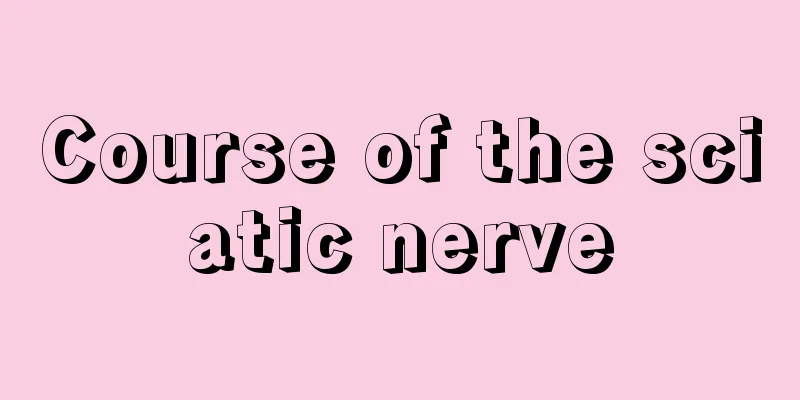Course of the sciatic nerve

|
I believe everyone should have some understanding of the sciatic nerve and should also know something about the role of the sciatic nerve in the human body. The sciatic nerve is the thickest and longest nerve in the human body, and its role in the human body cannot be ignored. There are also many important muscles in the human body distributed around the sciatic nerve, and the piriformis muscle is an important muscle around the sciatic nerve. Today, let’s sort out the main directions of the sciatic nerve. The longest and thickest nerve in the human body, and the main nerve of the sacral plexus in the spinal cord. It is composed of lumbar nerves and sacral nerves and can reach a diameter of about 1 cm. After exiting the pelvis from the inferior piriformis foramen, its main trunk and terminal branches extend over the entire dorsal side of the lower limb. The main trunk is located deep to the gluteus maximus, passes between the greater trochanter and the ischial tuberosity, descends to the dorsal side of the femur, and branches to the dorsal thigh muscles. The sciatic nerve is the motor nerve for the hamstring muscles, calf and foot muscles, and is also an important sensory nerve for the calf and foot. Branches of the sciatic nerve: 1. Articular branch - It arises from the upper part of the sciatic nerve, reaches the hip joint, and penetrates from the back of the joint capsule. 2. Muscular branches - originate from the upper part of the thigh, including the branches that innervate the biceps femoris, semitendinosus, semimembranosus and adductor magnus. 1. Sciatic nerve injury: If the sciatic nerve is injured at the pelvic outlet or its upper end, the hamstring muscles, front and back muscles of the calf and foot will be completely paralyzed, the calf cannot be flexed, and the movement of the foot and toes is completely lost; the Achilles tendon and plantar reflexes disappear; and the sensation of the outer side of the calf and foot is lost. When the sciatic nerve is not completely damaged, burning pain often occurs. When the injury is in the lower part of the thigh, such as injury to the ending branches of the hamstring muscles, knee flexion exercises can be done. The sciatic nerve divides into the tibial nerve medially and the common peroneal nerve laterally in the popliteal fossa. The main symptoms of tibial nerve injury are: inability to plantar flex the foot, weak inversion force, inability to stand or walk on tiptoe, sensory impairment of the skin on the posterior calf and sole, and dorsiflexion and eversion of the foot. The main symptoms of common peroneal nerve injury are: inability to dorsiflex and evert the foot and inability to extend the toes. In addition, patients have difficulty walking with a special "threshold-crossing gait", sensory impairment in the anterior and lateral calf, dorsum of the foot, and dorsal toes, and due to gravity and excessive traction on the posterior muscles, they present with "clubfoot". 2. Sciatica: (I) Introduction: Sciatica is a syndrome of paroxysmal or persistent pain along the sciatic nerve pathway and its distribution area caused by primary or secondary damage to the sciatic nerve due to various reasons, often radiating from the buttocks to the posterior thigh, lateral calf and lateral dorsum of the foot. (2) Causes and clinical manifestations: Lumbar disc herniation is one of the main causes of sciatica. It is generally believed that the pathogenesis of sciatica caused by lumbar disc herniation is due to compression of the protruding nucleus pulposus and excessive stretching of the spinal nerve roots. At the nerve root site, the epineurium tissue is extremely underdeveloped and has no elastic buffering effect. It is mechanically compressed by the nucleus pulposus, and the nerve root is often easily damaged, causing radiating pain along the nerve root. The main symptoms are radiating from the waist to one side of the buttocks, the back of the thigh, the posterior and lateral side of the calf to the dorsum of the foot. There is fixed and obvious tenderness and percussion pain in the lumbar sacral region and spine, decreased sensation on the lateral side of the calf and dorsum of the foot, decreased or absent knee tendon and Achilles tendon reflexes, and the pain is aggravated by increased abdominal pressure due to coughing or sneezing. (III) Treatment: Western medicine treatment mainly adopts conventional comprehensive treatments such as various peripheral anti-inflammatory analgesics, nerve nutrition drugs, traction and rest on a hard bed. For more serious conditions, glucocorticoids, blockade, epidural injection and other treatment methods can be used. |
>>: Can I eat grape seeds if I have a bad stomach?
Recommend
What are the symptoms of stage 3 nasopharyngeal carcinoma
What are the symptoms of stage 3 nasopharyngeal c...
My head feels tight
The feeling of tightness in the head is likely ca...
What is vitamin d and what is its function
Vitamin D can help children's bone growth and...
What kind of water is best for mixing protein powder
Protein powder is not unfamiliar to many people w...
Nursing measures after osteosarcoma surgery
Osteosarcoma is a common primary malignant bone t...
Is myocardial ischemia easy to treat? Is diet therapy effective?
Patients with myocardial ischemia need to pay att...
What causes plum blossom rash
Pityriasis rosea and pityriasis rosacea are two d...
How far can an average person jump in triple jump
I believe everyone has seen triple jump in life. ...
How to deal with recurring fever caused by lung cancer
When lung cancer patients have symptoms of recurr...
Advantages of radiotherapy for patients with lymphoma
Radiotherapy can be used to treat lymphoma. Radio...
What foods can remove moisture from the body
If there is moisture in the body, it will have a ...
These first aid "home remedies" can really kill people
Seeking medical help from all sources when you ar...
How to treat warts
If you have warts on your body, what is going on ...
What to do with the dark area under the skin after thyroid cancer surgery
The appearance of a dark area under the skin at t...
What are the symptoms of late stage brain metastasis of lung cancer? Have these symptoms
Lung cancer patients develop brain metastases, an...









